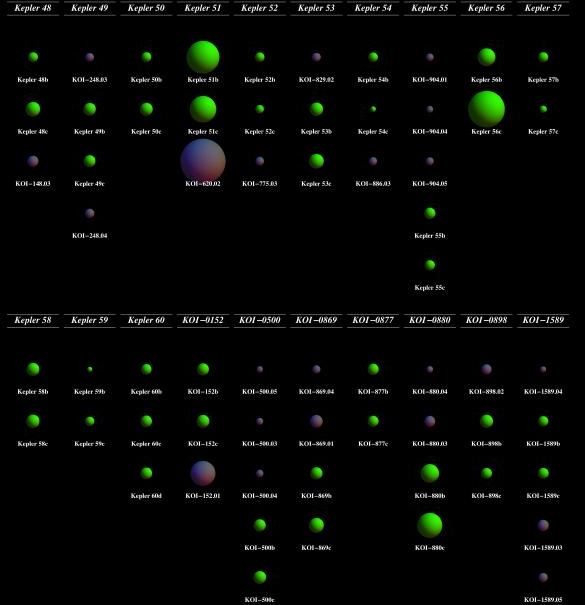

| Visitors Now: | |
| Total Visits: | |
| Total Stories: |

| Story Views | |
| Now: | |
| Last Hour: | |
| Last 24 Hours: | |
| Total: | |
Kepler Finds 41 New Planets And 2123 Planet Candidates To Be Confirmed
Two newly submitted studies verify 41 new transiting planets in 20 star systems These results may increase the number of Kepler’s confirmed planets by more than 50 percent: to 116 planets hosted in 67 systems, over half of which contain more than one planet. The papers are currently under scientific peer-review. There are also remains 2321 planet candidates yet to be confirmed.
Nineteen of the newly validated planetary systems have two closely spaced transiting planets and one system has three. Five of the systems are common to both of these independent studies.
The planets range from Earth-size to more than seven times the radius of Earth, but generally orbit so close to their parent stars that they are hot, inhospitable worlds.
The planets were confirmed by analyzing Transit Timing Variations (TTVs). In closely packed systems, the gravitational pull of the planets causes the acceleration or deceleration of a planet along its orbit. These “tugs” cause the orbital period of each planet to change from one orbit to the next. TTV demonstrates that two transiting planet candidates are in the same system and that their masses are planetary in nature.
“These systems, with their large gravitational interactions, give us important clues about how planetary systems form and evolve,” said lead researcher Jason Steffen, the Brinson postdoctoral fellow at Fermilab Center for Particle Astrophysics in Batavia, Ill. “This information helps us understand how our own solar system fits into the population of all planetary systems.”
Unlike our own solar system, Kepler-47 is home to two stars. One star is similar to the sun in size, but only 84 percent as bright. The second star is diminutive, measuring only one-third the size of the sun and less than one percent as bright. As the stars are smaller than our sun, the systems habitable zone is closer in.
The habitable zone of the system is ring-shaped, centered on the larger star. As the primary star orbits the center of mass of the two stars every 7.5 days, the ring of the habitable zone moves around.
This artist’s rendering shows the planet comfortably orbiting within the habitable zone, similar to where Earth circles the sun. One year, or orbit, on Kepler-47c is 303 days. While not a world hospitable for life, Kepler-47c is thought to be a gaseous giant, slightly larger than Neptune, where an atmosphere of thick bright water-vapor clouds might exist.

The two research teams used data from NASA’s Kepler space telescope, which measures dips in the brightness of more than 150,000 stars, to search for transiting planets.
“The sheer volume of planet candidates being identified by Kepler is inspiring teams to look at the planet confirmation and characterization process differently. This TTV confirmation technique can be applied to large numbers of systems relatively quickly and with little or no follow-up observations from the ground,” said Natalie Batalha, Kepler mission scientist at NASA’s Ames Research Center, Moffett Field, Calif. “Perhaps the bottleneck between identifying planet candidates and confirming them just got a little wider.”
Credit: Daniel Fabrycky
J Steffen et al, 2012, Transit Timing Observations from Kepler: VII; and, Ji-Wei Xie, 2012, Transit Timing Variation of Near-Resonant KOI Pairs
Ames Research Center in Moffett Field, Calif., manages Kepler’s ground system development, mission operations and science data analysis. NASA’s Jet Propulsion Laboratory, Pasadena, Calif., managed the Kepler mission’s development.
Ball Aerospace and Technologies Corp. in Boulder, Colo., developed the Kepler flight system and supports mission operations with the Laboratory for Atmospheric and Space Physics at the University of Colorado in Boulder.
The Space Telescope Science Institute in Baltimore archives, hosts and distributes Kepler science data. Kepler is NASA’s 10th Discovery Mission and is funded by NASA’s Science Mission Directorate at the agency’s headquarters in Washington.
For more information about the Kepler mission, visit: http://www.nasa.gov/kepler
Contacts and sources:
Michele Johnson
Ames Research Center, Moffett Field, Calif.




